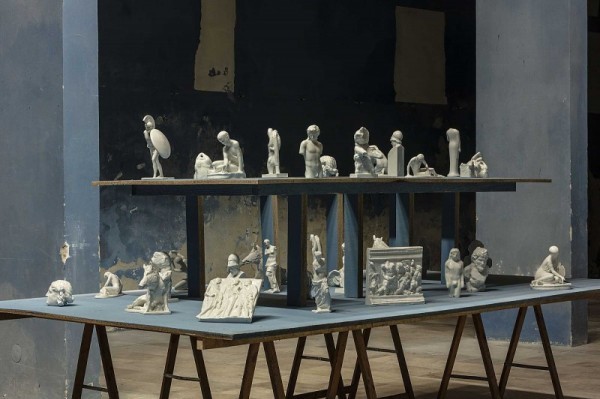The Blue Room / Installation and video 18″
The Blue Room is the result of a project started in 2017, aimed at the re-examination of our relation to architectural and material cultural heritage. The project merges two narratives: on the one hand, the story of the Hungarian Museum of Fine Arts’ plaster cast collection of antique sculptures, and on the other hand, that of the 18th century synagogue of Tata, which served to house the ‘temporary’ exhibition of life-size copies of antique sculptures for more than forty years.
Before World War 2, 10% of Tata’s population of 12 thousand residents were of Jewish origin, with several craftsmen and merchants amongst the members of the assimilated community. The better part of Tata’s industry, including the carpet-, leather-, and brick factories, was in the hands of Jewish tradesmen. A prominent figure in the history of the town was the Jewish factory owner Mór Fischer (1799-1880), the man who founded the porcelain factory of Herend and brought it to success.
After 1945, Jewish-owned properties, including the factories were transferred to the state, the synagogue used as a warehouse during the war was sold by the Jewish community to the City Council of Tata.
The damaged building was renovated in 1977 and repurposed to accommodate some of the Museum of Fine Arts’ late 19th century plaster copies of antique sculptures. In the summer of 2018, the sculptures were hauled away for conservation and to be exhibited with other plaster copies at the Csillag Fort of Komárom.
The Blue Room project comprises a film and an installation. The film takes place at the synagogue, showing the conservation specialists of the Museum of Fine Arts as they detach the plaster sculptures from their pedestals, before disjointing and boxing them to be hauled away. The building is gradually evacuated, only to be occupied anew by a group of art students who transform the space into a temporary atelier. The young artists craft small porcelain copies of the Greek and Roman sculptures, giving rise to an entirely new collection from the accurate miniature replicas of the plaster copies. Transubstantiated into a memorial of itself, the building is eventually given a new function, and the sculptures once inhabiting it appears in a different quality (material, size).
The film documents an artistic intervention that repurposes the building once the plaster copies are moved out, as a porcelain manufacturing workshop. Purchased with public funds in the 19th century, the antique replicas also used to serve educational purposes: art students copied antique sculptures in order to acquire the formal features of a universal beauty ideal. Today, however, young artists are engaged in the completion of tasks at a workshop of an entirely different character. The linear narrative of the film tells the present-day story of the building’s metamorphosis: the dismantling of the exhibition of antique sculptures, their removal, followed by the arbitrary occupation of the synagogue’s space and the manufacturing of copies of copies, and eventually the exhibition of this new collection.
The porcelain sculptures were made in collaboration with Edit Kondor, Zsuzsa Bokor, Mónika Csák teachers, and Henrietta Bodnár, Gabriella Farkas, Bernadett Fúró, Boglárka Nagy, Ágnes Nagy-György, Barbara Szőke, MA students of the Product Design Department at the MOME University.
Composed by violist and composer Viktor Bátki, the music of the film is a fusion of ancient Greek and Hebrew melodies. Its leitmotif is a combination of an ancient Greek enharmonic tetrachord scale of four notes (two major thirds and two quarter tones) and an ancient Greek tune fragment. The music was recorded by Bátki using an acoustic viola and a six-string electric viola, with effects pedals. With the help of these instruments, he imitated ancient plucked string and wind instruments as well as atmospheric noises. The bass track pulsating through the first section of the score comprises the phrase TATA in terms of both rhythm and pitch (in solfege terms: 2 quarter notes = TA-TA; in relative solmization: the B note can also be referred to as ‘TA’).
The curator Eszter Lázár has collaborated with Tehnica Schweiz on The Blue Room project throughout the
production.
Special thanks:
Máté Birkás, Edit Kondor and the 2nd year students of MOME (Henrietta Bodnár, Bernadett Fúró, Boglárka Nagy, Ágnes Nagy-György, Barbara Szőke), Katarina Šević, Léna Kútvölgyi, Dávid Pap / FabLab, Gábor Pados, Viktória Petrányi, Richárd Schmidtmayer, Dániel Sipos, Zsuzsa Toronyi, Tamás Végvári / Liget Project Budapest, Dániel Zafir
Project supported by:
acb Gallery, Péter Barta, Kuny Domokos Museum, FabLab Budapest, Karmazin Studio Budapest, Product Design Department – MOME, Proton Cinema, SILKEM Hungary Ltd., Péter Szauer, tranzit.hu
The Blue Room /video 18″
Directed by: Tehnica Schweiz (Gergely László & Péter Rákosi) / Camera: Péter Rákosi / Camera assistance: Dániel Zafir
Edited by: Antje Tina Las / Music: Viktor Bátki / Sound design: Gábor Ripl / Post production: Máté Birkás





